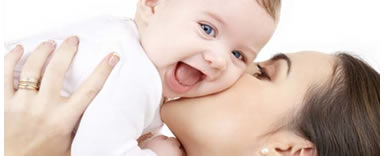Babies and Expected Mothers

Taking care of them starts before in the womb
The birth of a baby is usually a source of great anxiety to the mother, who always wonders about the steps to take so that her baby has a development as healthy as possible! And if genetic factors are responsible for allergic predisposition, environmental factors are responsible for causing sensitization and inflammatory response. In fact, we can find various causes for allergies in internal environments, such as mold, dust mites and pet allergens, among others.
How can a baby become allergic?
When inhaled, some substances can be transported across the placenta, such as cigarette toxins and some types of allergens. When the fetus gets in contact with these substances, an intrauterine sensitization may occur, leading to an initial allergic response. Therefore it's very important that the air quality is the best possible, at least in the places where the pregnant woman spend most of her time.
The main allergens in the air are mold and allergens from dust mite, pets and pollen.
A study conducted in England showed that it is possible to reduce the respiratory allergy symptoms in infants with predisposition to allergies or asthma. This is done by reducing the amount of allergens to which the infants are exposed in the environment.
Studies with identical twins show that there are cases where only one of the twins becomes asthmatic. This is one of the reasons that led investigators to consider that the environmental factors, and not just the genetic ones, are of great importance in the development of the disease.
Another study conducted with babies up to one year old showed that the asthmatic episodes are directly related to the exposure to dust mite allergens: the greater the exposure to dust mites, the greater the likelihood of an early development of the disease and crises.
The discomfort caused by nocturnal allergies can be bothersome to the point of interrupting the baby's sleep. And the time devoted to sleep is not only important for rest but also for the assimilation of knowledge and brain's development. Besides, it is during this period that occurs the most intense release of growth hormones.
AIRFREE® air purifiers are up to 99% efficient by destroying mold spores in the air, bacteria, viruses, ozone, allergens from dust and dust mites and other air pollutants, therefore representing a great ally in improving allergy sufferers’ quality of life.
How does it work?
It drastically reduces air allergens by incinerating microorganisms. As a result, contaminated air is dragged through the Airfree® ceramic centre and destroyed at high temperatures. This air purifying cycle is silent, requires no maintenance and is ensured by numerous tests.

FAQ
Q: If I install the Airfree in my room, my baby’s immune system will be weakened.
A: Fact 1: According to the EPA, indoor contamination can be up to 100 times worse than outside air.
Fact 2: Although test show that Airfree destroys 100% of germs passing through it, it never brings the room contamination down to 0. Besides, there is always a contamination increase when people come in, when air conditioning is turned on, when the bed is made and several other daily activities.
Fact 3: The baby will be in many other rooms other than inside the room where Airfree is installed.
Fact 4: It can be said based on microorganism reduction tests that the indoor contamination is brought to a clean and acceptable level. Remember some Airfree reduction studies were done where the indoor air contamination was 50 times higher than the outdoor contamination, which reflects EPA claims on IAQ levels.
Fact 5: Asthma rates have increased dramatically lately due to the new facilities with closed air condition facilities (new!).
→ Find Answers to Frequently Asked Questions
DOWNLOADS - BABIES & PREGNANCY


